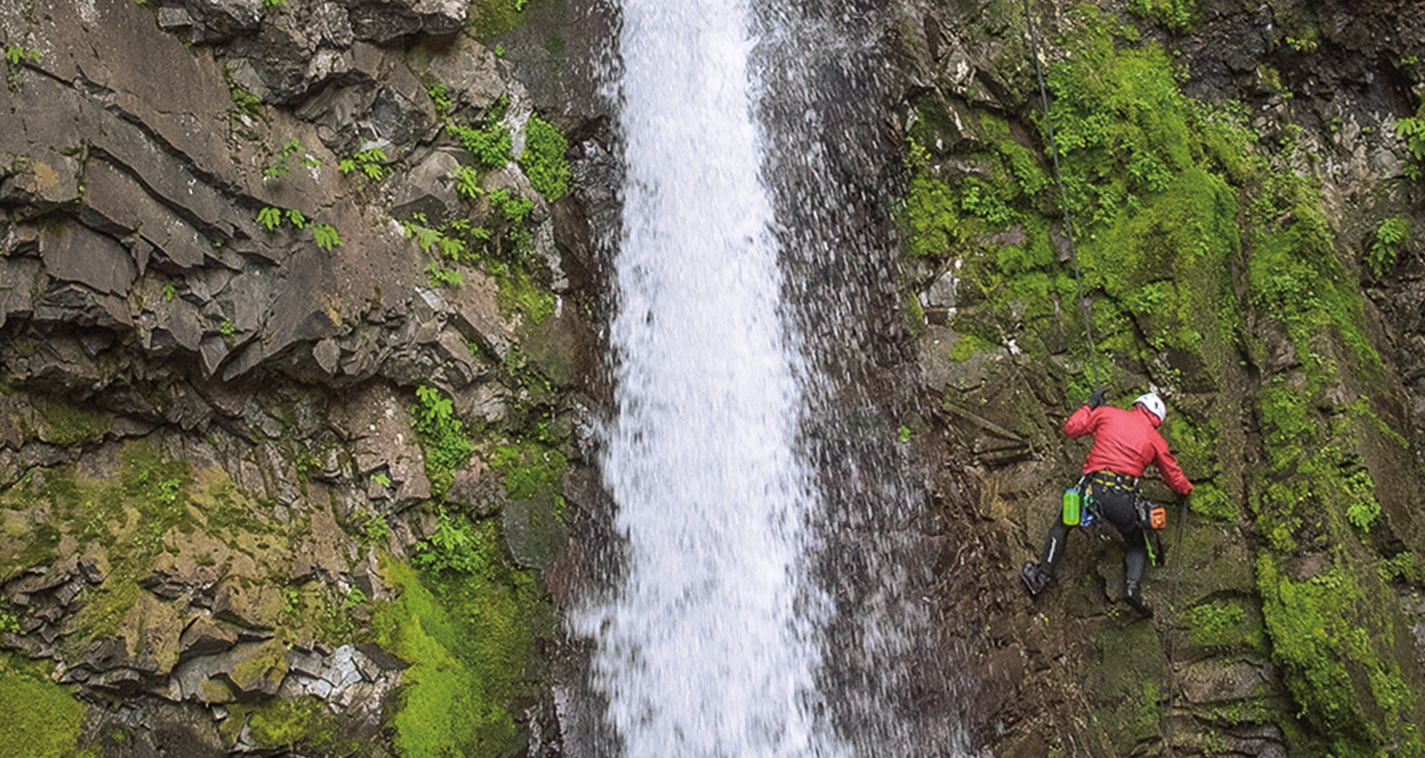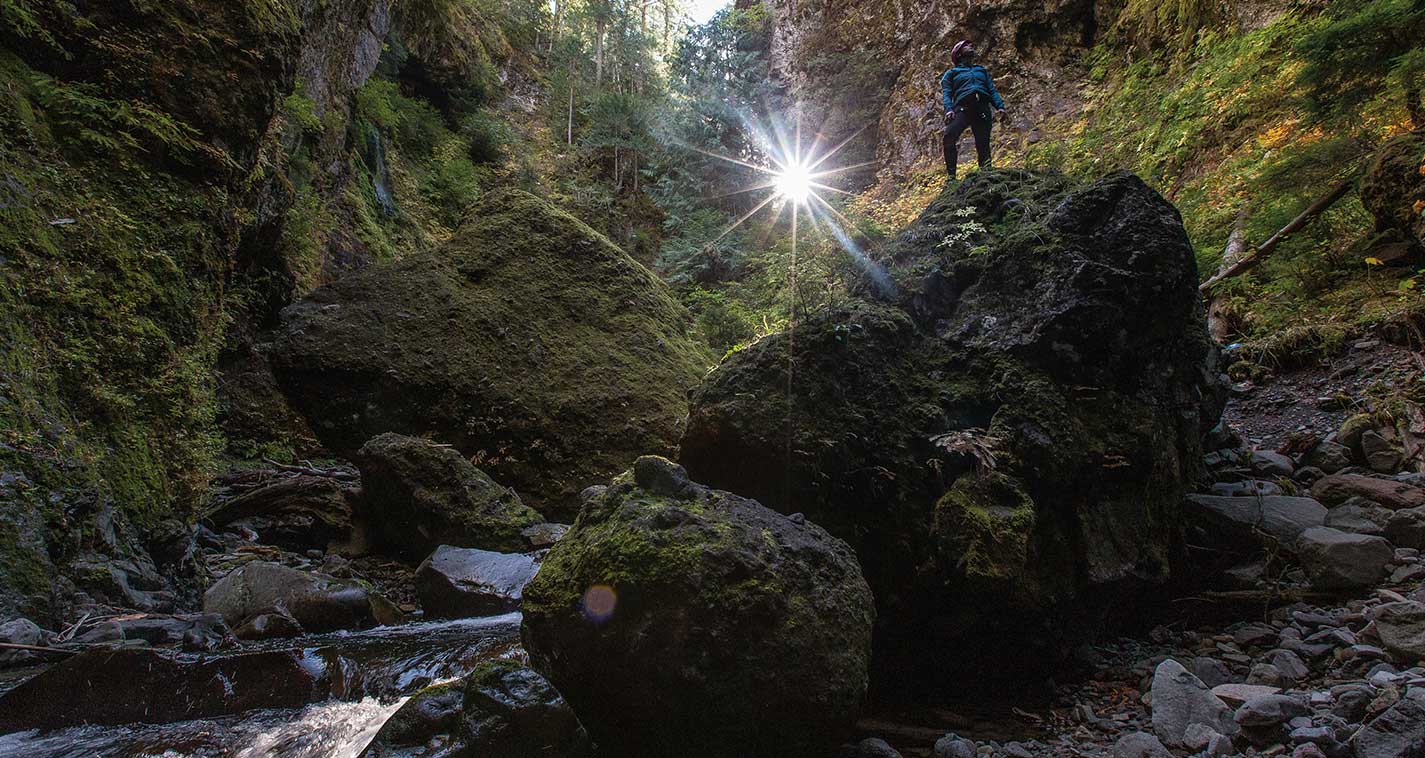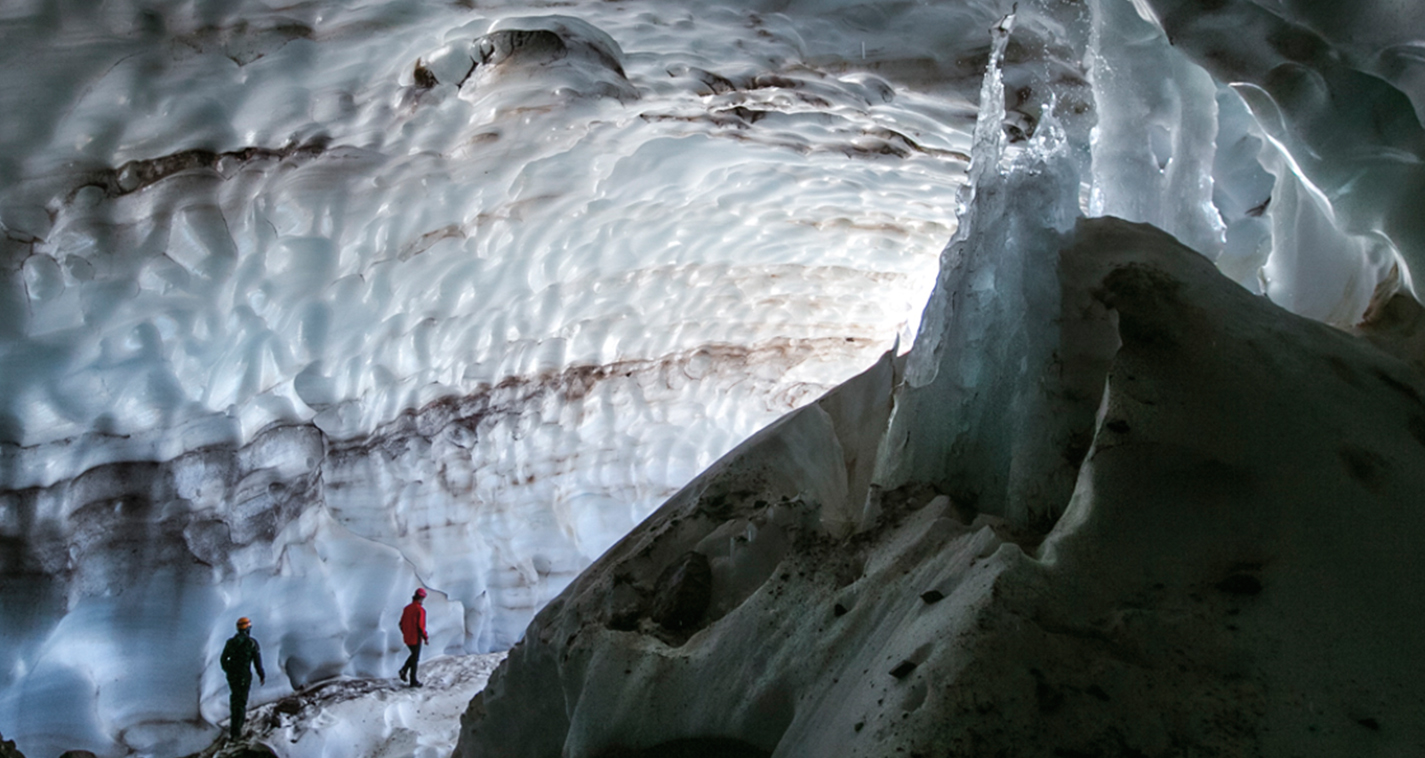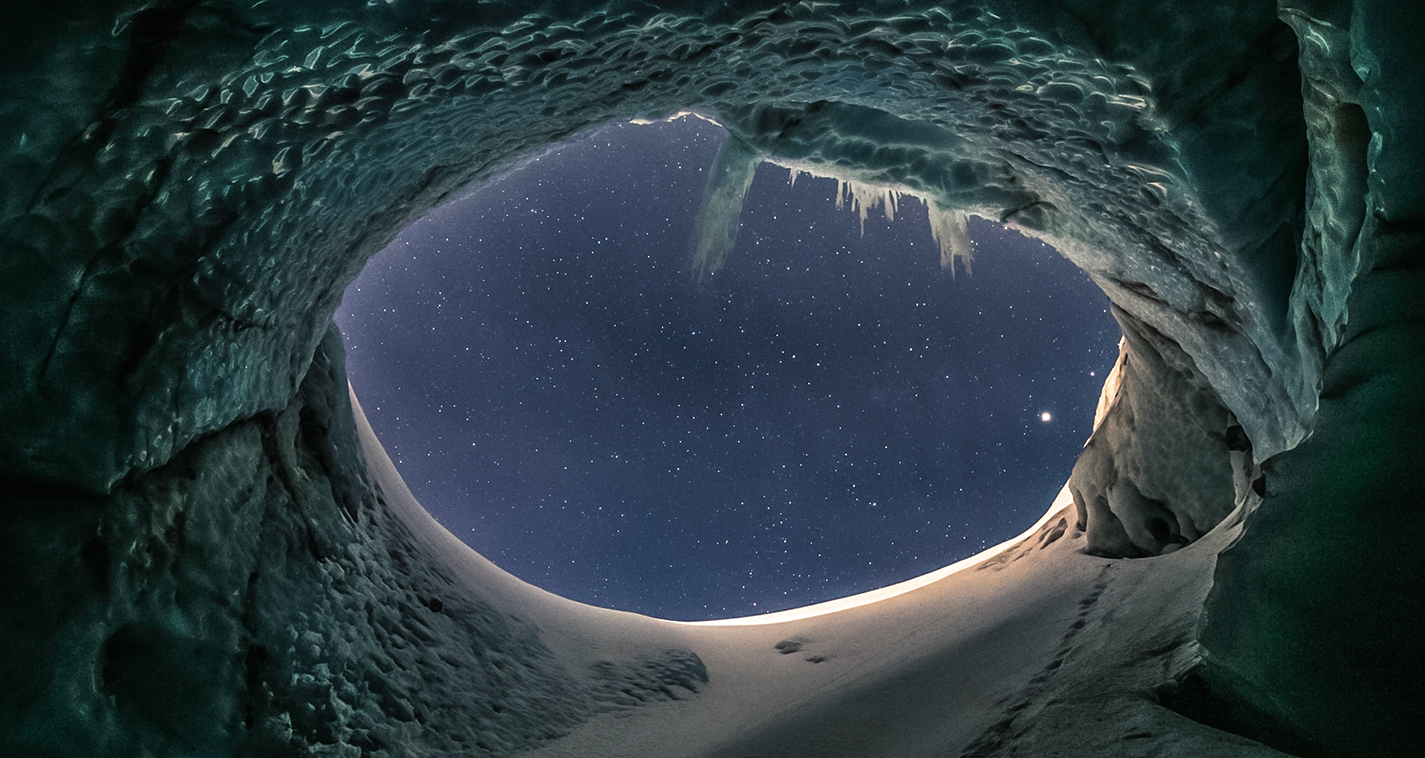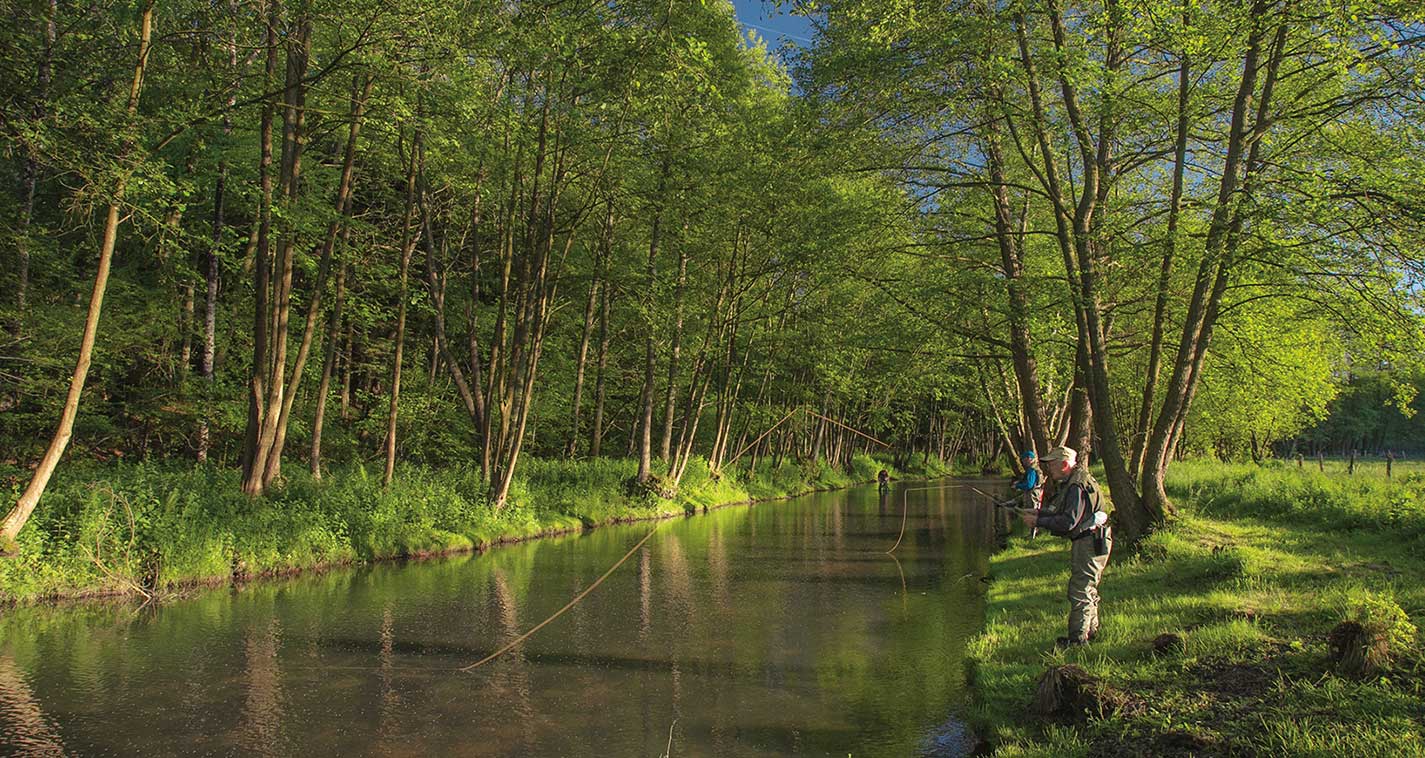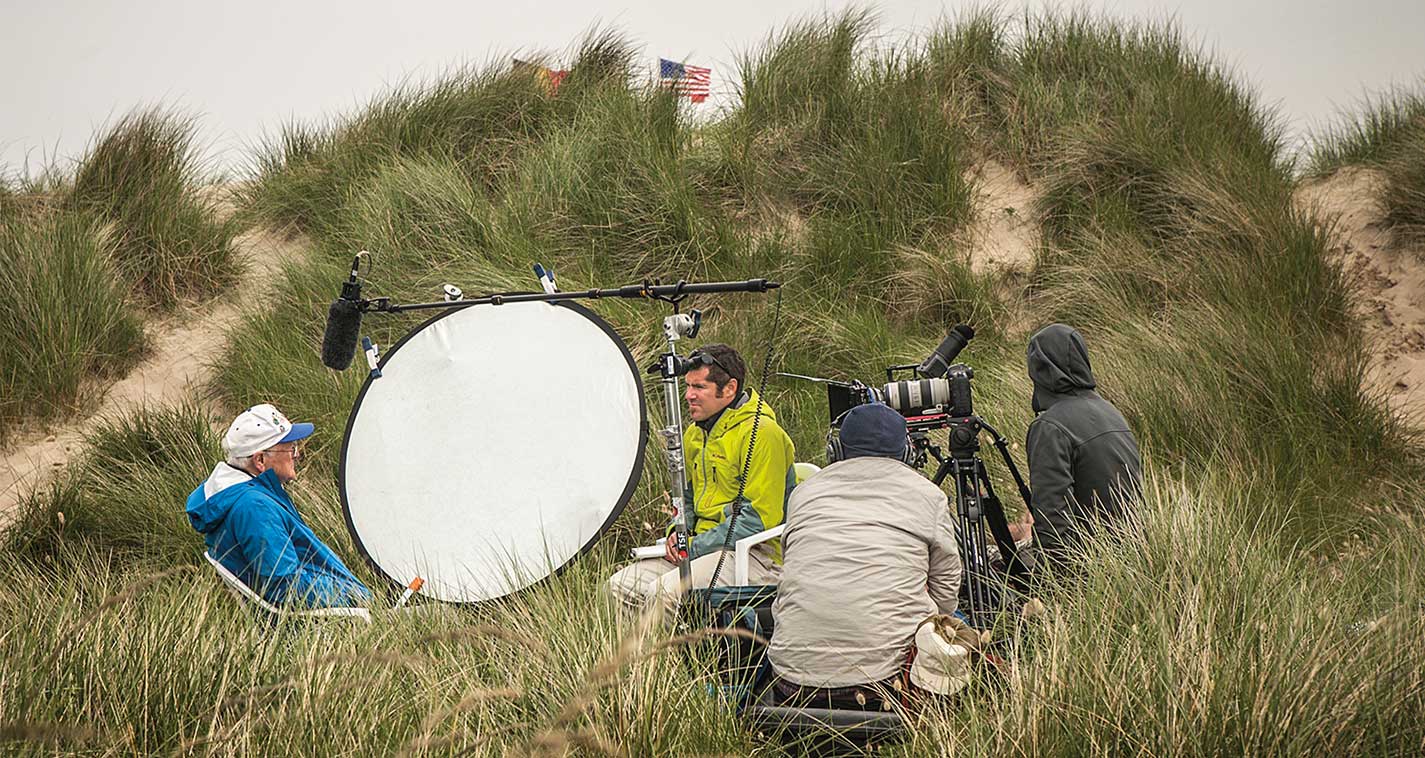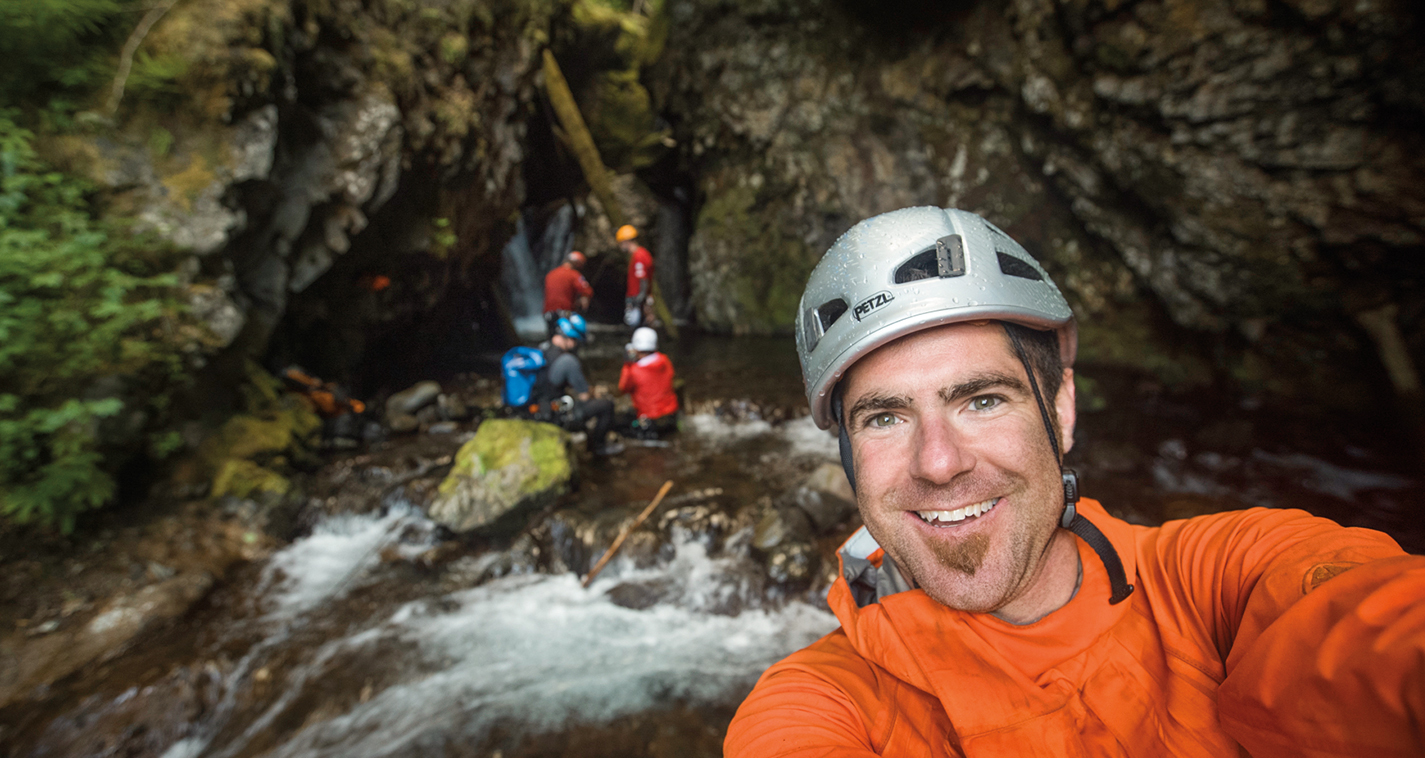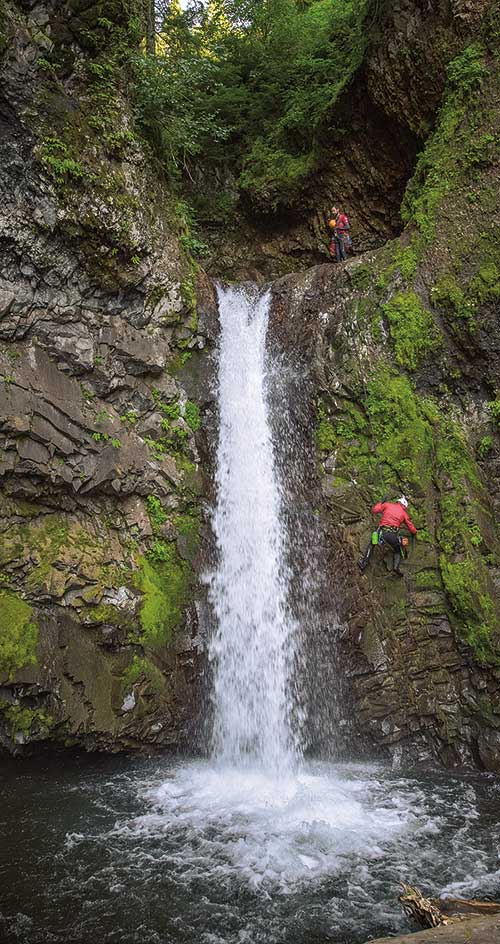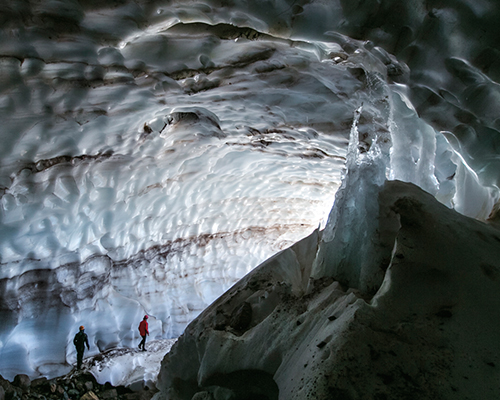John Waller ’98 is rappelling through a 40-foot waterfall. Water gushes over his camera, bounces off his helmet and cascades into the virgin rock crevices all around. A rope snakes overhead and out of view. Waller tugs it to test its hold, and then he begins to rappel farther down the waterfall. His nervous breath is mostly obscured by the roar of water.
Waller, an environmental science grad turned filmmaker, is descending into Valhalla.
He and his team are among the first people in recorded history to see the Valhalla Gorge, although in the end more than 340,000 households and 28,000 online viewers will also lay eyes on this rugged, remote slice of Oregon.
This episode — of Waller’s life, of the documentary he is making with Oregon Public Broadcasting (OPB), “Discovering Valhalla: Oregon’s Hidden Gorge” — begins nine waterfalls above the hidden slot canyon deep in the heart of the Mount Jefferson Wilderness. Like most slot canyons — gorges with steep walls, created through erosion and typically deeper than they are wide — Valhalla was carved by water and is now framed by waterfalls. It’s also remarkably well-hidden, covered all around by dense brush. In fact, until U.S. Forest Service veteran Mike Malone spotted the canyon from a helicopter while fighting a forest fire in 2010, only a few wilderness-lovers even knew it existed. It took Malone years of poring over Forest Service and topographical maps to pinpoint the slot canyon’s location about 20 miles outside Detroit, Oregon. Now, OPB and Waller have told Valhalla’s story.
Waller, business partner Ben Canales and professional guide Jared Smith begin their traverse of the newly named gorge in a dish-shaped basin framed by two waterfalls. They call it Shangri-La. The men are wet from the moment they follow a fork of the Breitenbush River out of a glade, filming all the while. At the end of the first day, and multiple waterfalls and caves later, the team makes camp on a rock ledge along the water’s edge — water that roars and teems and growls like a constant companion. You hear that sound, the crew says. You feel that sound. You’re in that sound.
For the next two days they are in that sound in a whole new way as they descend waterfall upon waterfall. They haul themselves, cameras, climbing gear and equipment toward the 200-foot-long slot canyon covered in moss as smooth and velvety as a putting green. Waller almost makes the descent look easy, although it isn’t. Unknowns are dangerous, and Valhalla is full of them.
The uncharted pool at the bottom of a waterfall could be knee deep, or 8-feet deep. The next stretch of river trail might hold a treacherous logjam or an unscalable cliff. The water is so cold that it will kill a person without a wetsuit. There’s no cell service, no place for a rescue helicopter to land. The nearest remote Forest Service road is only a few miles away, but thanks to the topography it might as well be 20 miles distant.
There’s an uncomfortable instant on the second day of the five-day expedition when the team reaches a 40-foot fall and has to rappel it, taking all the gear as they go and leaving behind nothing — including the climbing line.
“When the rope came down, we knew there was no hiking up and out,” Waller says. “There’s no other way out. There’s only downstream, into the unknown.”
So, down they go. Upstream would require someone to climb the waterfalls — including some very steep and technical drops — to place anchors. “It’s just a lot easier to go downstream than upstream,” Waller says.
And yet, John Waller has always gone upstream.
“That's a great leader”
When he graduated from Willamette in 1998 with a major in environmental science, Waller did not set out to become a filmmaker. Instead, he headed to Detroit, an hour east of the Willamette campus, to work for the Forest Service. Summers he served on the hotshot fire crew and conducted spotted owl surveys; in the winter he traveled Europe. By 2001 he was in Portland full time working as a backcountry and whitewater guide. He returned to college, earned a master’s degree in education and started teaching ninth-grade science.
Then, in 2004, he launched his own video production company, Uncage the Soul — the name comes from a tagline he used in the email newsletters he sent to family and friends while traveling the world. Back then, he was guiding part-time to make ends meet. Today Uncage the Soul produces documentary films, brand anthems, tourism videos and more for everyone from Nike to OPB. The company grosses around $1 million a year in terms of full video production. It’s not very big in the industry, says Waller, but he and Canales consider it a success for the lifestyle it affords them.
The business was about six years old and Waller was high in the Willamette Valley treetops when he met Jule Gilfillan, a producer for OPB’s 27-year-old magazine show, “Oregon Field Guide.” During the filming of “Treeverse” — a documentary about two tall-tree arborists on a five-day, one-kilometer, never-touching-the-ground trek through the Oregon white oak canopy — Waller impressed Gilfillan.
“He was tackling a really complex assignment in a unique fashion, and he was having a blast doing it,” says Gilfillan. “Everyone on his team was living in mud and rain. It was March — not a pleasant month in the Willamette Valley — and the entire crew was committed to this. Nobody was complaining. Everybody was having a great time. And I thought, ‘That’s a great leader.’” When Gilfillan saw the film, she was even more blown away. Four years later Waller and Gilfillan were making “Discovering Valhalla: Oregon’s Hidden Gorge” together.
Constant evolution
Outside, it’s sunny, but inside the pockmarked turquoise ice cave it has begun to rain. Sunlight and water pour simultaneously through a hole melted into the roof, as the camera pans to capture the scene. The cave’s mouth scallops, and widens, and then scallops again. “It is the light that accents my beauty. It is the light that will consume me,” a woman’s voice explains over the sound of running water. For seven minutes the ice caves melt and evolve before our eyes.
Waller’s documentary “Requiem of Ice” was a year and five gear-laden trips up Mount Hood in the making. In October 2013 he and Canales began documenting the deterioration of the Sandy Glacier Caves — the largest glacial caves system in the Lower 48. Since the filming nearly two years ago, some 40 to 50 percent of the system has collapsed. On each excursion, using time-lapse, high-speed and aerial photography, the men revealed the massive scale and intimate details of two caves that extend deep into Mount Hood’s Sandy Glacier. In the film, rivers form, snow blows and a kaleidoscope of stars passes over the cave’s newly formed oculus. It is simultaneously breathtaking and heartbreaking.
Waller wasn’t always this good. Trial and error taught him how to make films. Shoot. See errors. Fix. Repeat.
“Neither running a business nor filmmaking and photography was anything I had a formal experience or education in. It was a lot of spending time doing it, and kind of refining my own character and personality in that work,” he says. Even today he’s constantly encountering new equipment, new scenarios and new business issues, which means he has to be constantly learning.
“I really attribute my experience at Willamette to learning how to learn. Not exactly in the rote information I learned in classes, but the process by which you figure something out or learn about something,” he says. “On a daily basis I have to figure stuff out. Where does the confidence that you’ll be able to figure it out rather than be paralyzed come from? I can trace a lot of that back to Willamette.”
The work has changed him. He pays more attention to the minutiae than he used to, noticing not just the big vistas but also the subtle details and how to bring them to life. He’s a lot better at asking questions, at not coming to a meeting with judgment and answers, but rather as a blank slate. He has seen a lot of unexpected things happen, he says, which has made him less reactive to unexpected situations. Perhaps that’s to be expected when you’re shooting inside a waterfall or a melting cavern of ice.
Glaciers and seasides; slot canyons and oak canopies: It’s obvious that Waller’s work is shaped by nature. He loves the outdoors and spends a lot of time there so it’s only natural his work would celebrate it. Yet he isn’t on a mission to save the world or protect its wild places. In fact, he might even argue that his work, like “Discovering Valhalla,” puts those wild places in peril.
“You have this beautiful canyon, untouched by humans, and here we were producing a big documentary about it,” Waller says. “Part of me feels responsible for the consequences of that. Inevitably people will go there. Combine all these small impacts and you have a big one. It doesn’t take much to make an impact that lasts hundreds of years, and that’s a bit troubling to me. That’s the environmental science major coming out in me. ... ‘The consequences of collective action on a landscape.’ I haven’t been able to shed that, either. I think the profs would nod their heads and say ‘Yep, you get it.’”
Learning about love
The boats land near shore in grainy black and white. Men, knee-deep in the ocean and clad in uniforms and packs and helmets, hold guns aloft as they wade toward shore. Fast-forward — 7 minutes or 69 years — and there’s the soldier again, surrounded now by lush, green foliage. Knee-deep again in French water, he uncurls a fly line overhead and then watches it unspool away from him down the river.
Only about 70 percent of Uncage’s work is commercial, produced for clients such as Nike, Adidas, Travel Portland and Stella Artois. Maybe it’s because Waller isn’t overly motivated by money, maybe it’s because storytelling is in his soul, or maybe it’s because he loves doing good in the world while fueling his own independent spirit. Whatever the reason, he’s driven by this other 30 percent — the less lucrative jobs, the passion projects such as “Requiem of Ice” and “Mending the Line.”
Several years ago Waller was on the Umpqua River producing a short tourism video when he asked his subject, 91-year-old fly fisherman Frank Moore, what in his life remained undone. The answer — that Moore dreamt of returning to France to fly fish the rivers he had humped past as a World War II soldier — would not let the filmmaker go.
“I just couldn’t go on not making that happen for him. It wasn’t an option,” says Waller. Uncage the Soul gathered its resources, launched a crowdfunding campaign that raised nearly $60,000, and took Moore and his wife of 70 years, Jeanne, to Normandy to fly fish those rivers. From this they produced the 45-minute documentary “Mending the Line.”
While on the surface the film may seem to be about a WWII veteran’s healing journey, or a fly-fishing excursion, Waller says “Mending the Line” is actually a love story. The Moores’ marriage withstood his two years in the war, a business, and the loss of a child — all heartbreaks and vulnerabilities they shared with Waller and his crew. And yet, while the couple may be in their 90s, they still act like honeymooners.
“That project made me a lot more loving for a lot of people in my life. It taught me a lot about love,” Waller says. “It’s really a model for how to be in a relationship with another person, whether you’re married or not. You look at it and think, ‘Yeah, I’d like something like that, it looks pretty good.’”
What’s scripted next for Waller himself remains to be seen. In March he temporarily closed the business and took off on a 21-day rafting trip down the Colorado River. He swore to himself it wouldn’t be a working trip, that he wouldn’t become attached to or distracted by the one camera he was bringing along. Several projects awaited his return: a recruitment video for the Portland Police Bureau, a piece for the Multiple Myeloma Research Foundation about trekking the Grand Canyon, and another job in Machu Picchu.
In between all those, Waller will spend some time at his favorite place in Oregon. As for where, he won’t say. Waller knows about the beauty and tragedy of sharing wild places.
Freelancer Julie H. Case writes regularly about travel, alums, wine and geeky stuff for regional and national publications.
This article originally appeared in the summer 2016 issue of Willamette magazine.

